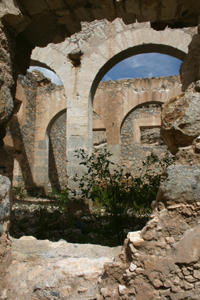REAL DE CATORCE, MEXICO - As my eyes adjust after the 2.3 km ride through the narrow Ogarrio Tunnel, the small Mexican ciudad de fantasma, or ghost town, of Real de Catorce comes into full view.
Local indigenous people sell their wares on the side of the dusty road in this town perched over 2,700 m high in the middle of San Luis Potosi state, about three hours outside of the namesake capital city.
The peyote-lined dirt road that leads up the mountains to the tunnel, the only convenient access point to the town, is narrow and treacherous and offers an appropriate introduction to the area.
The first gold and silver mines were founded in Real de Catorce in 1772, but by some accounts European settlement in the area dates back as far as 1638.
Before then and still today, the local Huicholes indigenous people ventured to the region on foot for a yearly religious ceremony.
Religion would prove to be the town’s saving grace when the last mine closed here in 1990. The population in that year, which peaked at around 40,000 people in the mining heyday of the 19th century, plummeted from about 18,000 to just 1,300 today.
According to town representative Filippe Frias, 85 per cent of visitors come here to pray to St. Francis at the 19th century San Francisco de Assis church in Plaza Hidalgo—the saint is said to have worked miracles for locals.


Left: Mining ruins near Real de Catorce. (Chris Atchison/ITD) Right: Gallero (cock trainer) Jose Tovar. (Chris Atchison/ITD)
The rest enjoy Real de Catorce’s colonial charm and tread lightly as they navigate the steep, cobbled streets.
“The stones in this town are like women, the more beautiful they are, the more dangerous,” Frias says through a translator.
While most Canadians—last year close to one million—visit Mexico for sun and sand, Real de Catorce offers a different view of a country which at one time achieved immense prosperity through mining.
Nowadays it’s common to see hippies mixed into the blend of domestic and foreign visitors on Real’s quiet streets—the entire town shuts down at sunset, incidentally—who come here for peace, tranquility, and a little hallucinogenic peyote.
It’s not uncommon to see a few celebrity faces, as well. The old stone buildings recently served as the backdrop for the second installment in the Zorro film franchise, and before that played host to Julia Roberts and Brad Pitt, stars of the 2001 film The Mexican.
Roberts frequented the restaurant at the hotel Meson de la Abundanzia, one of almost 20 small inns in the town, but the only one that accepts credit cards—time does tend to stand still here, after all.
Roberts would also see the local heli-port named sarcastically in her honor after complaining about the dust kicked up by her helicopter as she arrived to and departed from the set of The Mexican each morning.
For my departure I opt for the rocky, goat path-like route over the mountains for some spectacular views of the town. Four-wheel drive journeys like this one cost about $8 and a horseback option is available for about half the price.The mystical aspect of this once-thriving mining centre draws most people back here again. I plan the same return trip, knowing full well that as time draws on, little will have changed in Real de Catorce.
About the Author
Marc Atchison is a veteran journalist and a seasoned traveller with more than 20 years of travel writing experience. As the former Travel Editor of the Toronto Star, Canada's largest newspaper, and now Editor-in-Chief and Senior Writer for TraveLife magazine (Canada) and travelife.ca, Marc has been to over 100 countries in the world. Japan is one of his favorite destinations and he's been there on numerous occasions.